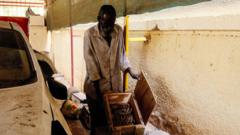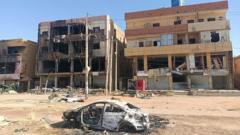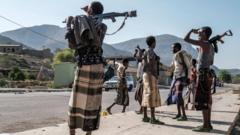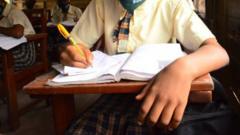Syrians are documenting the remnants of their recent history, aiming to create a reminder of their struggles and a roadmap for future generations to avoid repeating past atrocities.
**Memorializing a Revolution: Syrians Strive to Honor Their Struggles**

**Memorializing a Revolution: Syrians Strive to Honor Their Struggles**
As Syria begins to heal from years of civil war, citizens are committed to preserving the memories of their uprising against oppression.
In the wake of a long and devastating civil war, citizens across Syria are emerging from the shadows of conflict and actively working to preserve the remnants of their fight against the authoritarian rule of President Bashar al-Assad. In towns like Kafranbel, locals are meticulously collecting banners, posters, graffiti, and even turning artillery shells into pieces of art as a testament to their resistance.
The aim is not only remembrance but also to ensure these artifacts serve as a stark reminder of the sacrifices made during the conflict—a cautionary tale that future generations can learn from. Individuals like Mutassim Abdulsatir, a survivor of the notorious Sednaya prison, express a deep emotional need to document these memories. “You might say we need to forget these scenes. But I don’t want to forget,” he emphasizes. Abdulsatir is among those salvaging remnants of the oppressive regime, collecting items that once symbolized the brutality faced by many.
These saved artifacts include torture devices, documents, and even digital records of the regime's actions. The hope is that these will not only help in ensuring accountability but also in fostering a culture of justice within a society that has endured unspeakable horrors. The ongoing efforts highlight a collective determination to turn pain into a powerful narrative that prevents history from repeating itself, not only in Syria but worldwide.
The aim is not only remembrance but also to ensure these artifacts serve as a stark reminder of the sacrifices made during the conflict—a cautionary tale that future generations can learn from. Individuals like Mutassim Abdulsatir, a survivor of the notorious Sednaya prison, express a deep emotional need to document these memories. “You might say we need to forget these scenes. But I don’t want to forget,” he emphasizes. Abdulsatir is among those salvaging remnants of the oppressive regime, collecting items that once symbolized the brutality faced by many.
These saved artifacts include torture devices, documents, and even digital records of the regime's actions. The hope is that these will not only help in ensuring accountability but also in fostering a culture of justice within a society that has endured unspeakable horrors. The ongoing efforts highlight a collective determination to turn pain into a powerful narrative that prevents history from repeating itself, not only in Syria but worldwide.



















